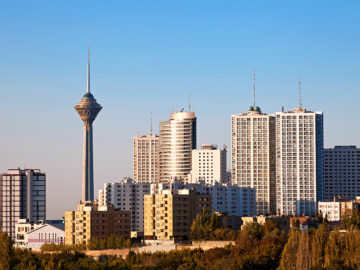Tehran province including 16 counties and Tehran city as its center and the capital of Iran as well, with an area of 13,692 square kilometers ranks the 29th largest province of the country. Its neighbors are Mazandaran, Alborz, Semnan, Markazi, and Qom. Tehran city with as many as about nine million residents is the most populated city of the country, where various ethnic groups originally from different parts of Iran live while the official language is Farsi. Its major immigrants are of Azeri and Mazandarani folks.
The mountains of central Alborz including known summits such as Damavand surround the north of Tehran. Because of altitude differences, Tehran has a considerable diversity of climates such that the higher the altitude, the higher the rainfall and the lower the temperature, and vice versa.

Tehran province is one of the oldest areas of Iran’s central plateau with human settlement dating back to the pre-Islamic period, the time of the Median Empire (678-549 B.C.). One of the most important historical cities of the region is Ray city placed near Tehran city in the current Tehran province. At the time, Tehran was in fact a large village located between Ray and the foothills of Alborz Mountain.
By the commencement of the Safavid Dynasty (1501-1736), Tehran came to the attention of the Shiite Safavid rulers because of neighboring Imāmzādeh Hamzah tomb – the ancestor of Safavid kings – and the holy shrine of Abd al-Azim al-Hasani. The Safavid kings would accommodate in Tehran when going to visit the Shrine of their ancestors in Ray. The expansion of traveling to Ray convinced Shah Tahmasp Safavid to build watchtowers and fortification for Tehran.
During the Afsharid Dynasty (1736-1796), the significance of Tehran was boomed, leading Karim Khan Zand to turn it into the center of his government for four years. It was finally chosen as the capital of Iran by Aqa Mohammad Khan, the first Qajar Dynasty’s (1796-1925) king and was entitled “Dar al-Khelafeh” meaning the capital of a country. Following the expansion of the Qajar government’s power, Tehran developed more and this has been continuing to the present. Of its natural attractions include Ski resorts of Tochal, Shemshak, and Darband Sar.
The Golestan Palace as the mansion of Qajar’s kings remained from Zand (1751-1794) and Qajar Dynasties dating back to 440 years ago and witnessing great historical events, was registered as the UNESCO World Heritage Site.
Furthermore, there are more than 30 diverse museums with valuable collections in Tehran. For example, the National Museum comprising two sections of Ancient Persia and the Islamic Museum is one of the main museums of the capital. The Museum of National Treasury and the Carpet Museum are other popular museums of the city, while Azadi Tower, Tehran Bazaar, Milad Tower Cultural Complex, and Sa’dabad Museum-Palace are also among the attractions. The main attractions of Ray city also include Abd al-Azim al-Hasani shrine, Tughrul Tower, and Cheshmeh-Ali.
Among the various handicrafts of the province, it can be pointed out to vitreous enamel (Minakari), Jajim (a kind of rug), wood products, and painting on glass and leather. Of the examples of native foods are different kinds of kebab, Dizy (meat stew), Aush (a kind of soup), and Dampokhtak (rice and beans). Zakariyyā al-Rāzī (scientist), Jahān Pahlevān Takhti (wrestler), Fereydoon Moshiri (poet), and Ali Akbar Dehkhoda (linguist) are among the celebrities of Tehran province.

